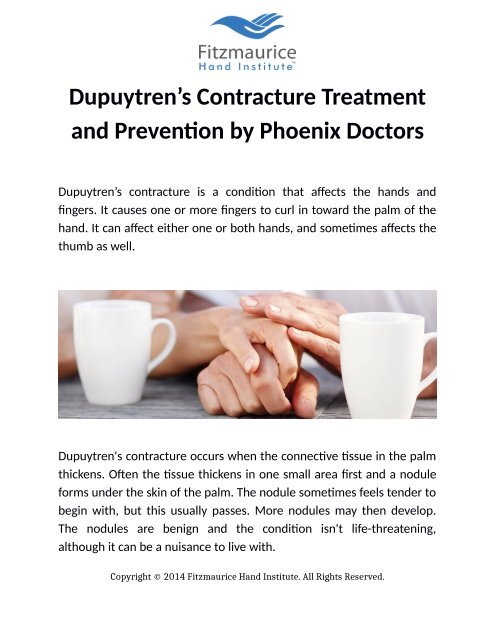Dupuytren’s Contracture Treatment and Prevention by Phoenix Doctors
Hand surgery especially Dupuytren's contracture surgery requires intensive care. Call (480)719-4750 Fitzhandmaurice hand institute for standard surgical procedures.
Hand surgery especially Dupuytren's contracture surgery requires intensive care. Call (480)719-4750 Fitzhandmaurice hand institute for standard surgical procedures.
Create successful ePaper yourself
Turn your PDF publications into a flip-book with our unique Google optimized e-Paper software.
<strong>Dupuytren’s</strong> <strong>Contracture</strong> <strong>Treatment</strong><br />
<strong>and</strong> <strong>Prevention</strong> <strong>by</strong> <strong>Phoenix</strong> <strong>Doctors</strong><br />
<strong>Dupuytren’s</strong> contracture is a condition that affects the h<strong>and</strong>s <strong>and</strong><br />
fingers. It causes one or more fingers to curl in toward the palm of the<br />
h<strong>and</strong>. It can affect either one or both h<strong>and</strong>s, <strong>and</strong> sometimes affects the<br />
thumb as well.<br />
Dupuytren's contracture occurs when the connective tissue in the palm<br />
thickens. Often the tissue thickens in one small area first <strong>and</strong> a nodule<br />
forms under the skin of the palm. The nodule sometimes feels tender to<br />
begin with, but this usually passes. More nodules may then develop.<br />
The nodules are benign <strong>and</strong> the condition isn't life-threatening,<br />
although it can be a nuisance to live with.<br />
Copyright © 2014 Fitzmaurice H<strong>and</strong> Institute. All Rights Reserved.
Basically, the condition is a painless, thickening <strong>and</strong> tightening of the<br />
fibrous tissue that leads to curled fingers.<br />
The Cause of <strong>Dupuytren’s</strong> <strong>Contracture</strong> - <strong>Phoenix</strong> <strong>Doctors</strong>:<br />
The cause of Dupuytren's contracture is unknown, but doctors know<br />
that it is not caused <strong>by</strong> an injury or heavy use of the h<strong>and</strong>. There are<br />
some factors that are associated with this condition, however. These<br />
include: Northern European descent, heredity, alcohol consumption,<br />
<strong>and</strong> advancing age. The condition is more common after the age of 40.<br />
Men are affected more often than women. Risk factors are alcohol use,<br />
diabetes, <strong>and</strong> smoking.<br />
Copyright © 2014 Fitzmaurice H<strong>and</strong> Institute. All Rights Reserved.
The Symptoms of <strong>Dupuytren’s</strong> <strong>Contracture</strong>:<br />
One or both h<strong>and</strong>s may be affected. The ring finger is affected most<br />
often, followed <strong>by</strong> the little, middle, <strong>and</strong> index fingers. A small, nodule<br />
or lump develops in the tissue below the skin on the palm side of the<br />
h<strong>and</strong>. Over time, it thickens into a cord-like b<strong>and</strong>. Usually, there is no<br />
pain. In rare cases, the tendons or joints become inflamed <strong>and</strong> painful.<br />
Other possible symptoms include itching, pressure, burning, or tension<br />
As time passes, it becomes difficult to extend or straighten the fingers.<br />
In severe cases, straightening them is impossible. The symptoms for<br />
<strong>Dupuytren’s</strong> <strong>Contracture</strong> occur gradually <strong>and</strong> grasping objects becomes<br />
a problem. It is a condition that can affect daily life to a great extent,<br />
leading to increasing loss of abilities over time.<br />
Copyright © 2014 Fitzmaurice H<strong>and</strong> Institute. All Rights Reserved.
<strong>Treatment</strong> for <strong>Dupuytren’s</strong> <strong>Contracture</strong> <strong>Phoenix</strong> <strong>Doctors</strong><br />
Many cases of Dupuytren's contracture are mild <strong>and</strong> don't need<br />
treatment. <strong>Treatment</strong> may be helpful if the condition is interfering with<br />
the normal functioning of your h<strong>and</strong>. Non-surgical treatments include<br />
radiation therapy <strong>and</strong> injections with a medication. In more severe<br />
cases, surgery can help to restore h<strong>and</strong> function. The two most<br />
common surgical techniques are:<br />
<br />
<br />
Open fasciectomy– where the shortened connective tissue is<br />
cut to relieve tension<br />
Fasciectom– where the shortened connective tissue is removed<br />
Needle aponeurotomy is another very effective procedure <strong>by</strong><br />
Dupuytren's contracture <strong>Phoenix</strong> <strong>Doctors</strong>. This involves inserting a<br />
small needle into the affected area to divide <strong>and</strong> cut the thickened<br />
b<strong>and</strong>s of tissue. There is usually little pain afterward b<strong>and</strong> healing is<br />
faster than with surgery. <strong>Treatment</strong> is provided <strong>by</strong> doctors who are<br />
extremely skilled <strong>and</strong> excellent in their field. Visit www.fitzh<strong>and</strong>.com to<br />
book an appointment now or for more info.<br />
Fitzmaurice H<strong>and</strong> Institute provides beneficial <strong>and</strong> effective treatments,<br />
both surgical <strong>and</strong> non-surgical, for all h<strong>and</strong>-related issues.<br />
Copyright © 2014 Fitzmaurice H<strong>and</strong> Institute. All Rights Reserved.


